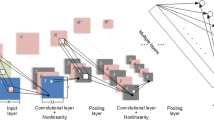Abstract
To process sensor data in the Internet of Things (IoTs), embedded deep learning for 1-dimensional data is an important technique. In the past, CNNs were frequently used because they are simple to optimise for special embedded hardware such as FPGAs. This work proposes a novel LSTM cell optimisation aimed at energy-efficient inference on end devices. Using the traffic speed prediction as a case study, a vanilla LSTM model with the optimised LSTM cell achieves 17534 inferences per second while consuming only 3.8 \(\upmu \)J per inference on the FPGA XC7S15 from Spartan-7 family. It achieves at least 5.4\(\times \) faster throughput and 1.37\(\times \) more energy efficient than existing approaches.
Access this chapter
Tax calculation will be finalised at checkout
Purchases are for personal use only
Similar content being viewed by others
References
Azari, E., Vrudhula, S.: An energy-efficient reconfigurable LSTM accelerator for natural language processing. In: 2019 IEEE International Conference on Big Data (Big Data), pp. 4450–4459. IEEE (2019)
Burger, A., Qian, C., Schiele, G., Helms, D.: An embedded CNN implementation for on-device ECG analysis. In: 2020 IEEE International Conference on Pervasive Computing and Communications Workshops (PerCom Workshops), pp. 1–6. IEEE (2020)
Cao, S., et al.: Efficient and effective sparse LSTM on FPGA with bank-balanced sparsity. In: Proceedings of the 2019 ACM/SIGDA International Symposium on Field-Programmable Gate Arrays, pp. 63–72 (2019)
Chen, J., Hong, S., He, W., Moon, J., Jun, S.W.: Eciton: very low-power LSTM neural network accelerator for predictive maintenance at the edge. In: 2021 31st International Conference on Field-Programmable Logic and Applications (FPL), pp. 1–8. IEEE (2021)
Fu, R., Zhang, Z., Li, L.: Using LSTM and GRU neural network methods for traffic flow prediction. In: 2016 31st Youth Academic Annual Conference of Chinese Association of Automation (YAC), pp. 324–328. IEEE (2016)
Manjunath, N.K., Paneliya, H., Hosseini, M., Hairston, W.D., Mohsenin, T., et al.: A low-power LSTM processor for multi-channel brain EEG artifact detection. In: 2020 21st International Symposium on Quality Electronic Design (ISQED), pp. 105–110. IEEE (2020)
Meher, P.K.: An optimized lookup-table for the evaluation of sigmoid function for artificial neural networks. In: 2010 18th IEEE/IFIP International Conference on VLSI and System-on-Chip, pp. 91–95. IEEE (2010)
Namin, A.H., Leboeuf, K., Wu, H., Ahmadi, M.: Artificial neural networks activation function HDL coder. In: 2009 IEEE International Conference on Electro/Information Technology, pp. 389–392. IEEE (2009)
Olah, C.: Understanding LSTM Networks [EB/OL]. https://colah.github.io/posts/2015-08-Understanding-LSTMs/. Accessed 27 Aug 2015
Otte, S., Liwicki, M., Zell, A.: Dynamic cortex memory: enhancing recurrent neural networks for gradient-based sequence learning. In: Wermter, S., et al. (eds.) ICANN 2014. LNCS, vol. 8681, pp. 1–8. Springer, Cham (2014). https://doi.org/10.1007/978-3-319-11179-7_1
Sun, Z., et al.: FPGA acceleration of LSTM based on data for test flight. In: 2018 IEEE International Conference on Smart Cloud (SmartCloud), pp. 1–6. IEEE (2018)
Xilinx: Power Analysis and Optimization, rev. 2, January 2021
Zhang, Y., et al.: A power-efficient accelerator based on FPGAs for LSTM network. In: 2017 IEEE International Conference on Cluster Computing (CLUSTER), pp. 629–630. IEEE (2017)
Acknowledgements
The authors acknowledge the financial support by the Federal Ministry of Education and Research of Germany in the KI-LiveS project.
Author information
Authors and Affiliations
Corresponding author
Editor information
Editors and Affiliations
Rights and permissions
Copyright information
© 2023 The Author(s), under exclusive license to Springer Nature Switzerland AG
About this paper
Cite this paper
Qian, C., Ling, T., Schiele, G. (2023). Enhancing Energy-Efficiency by Solving the Throughput Bottleneck of LSTM Cells for Embedded FPGAs. In: Koprinska, I., et al. Machine Learning and Principles and Practice of Knowledge Discovery in Databases. ECML PKDD 2022. Communications in Computer and Information Science, vol 1752. Springer, Cham. https://doi.org/10.1007/978-3-031-23618-1_40
Download citation
DOI: https://doi.org/10.1007/978-3-031-23618-1_40
Published:
Publisher Name: Springer, Cham
Print ISBN: 978-3-031-23617-4
Online ISBN: 978-3-031-23618-1
eBook Packages: Computer ScienceComputer Science (R0)




